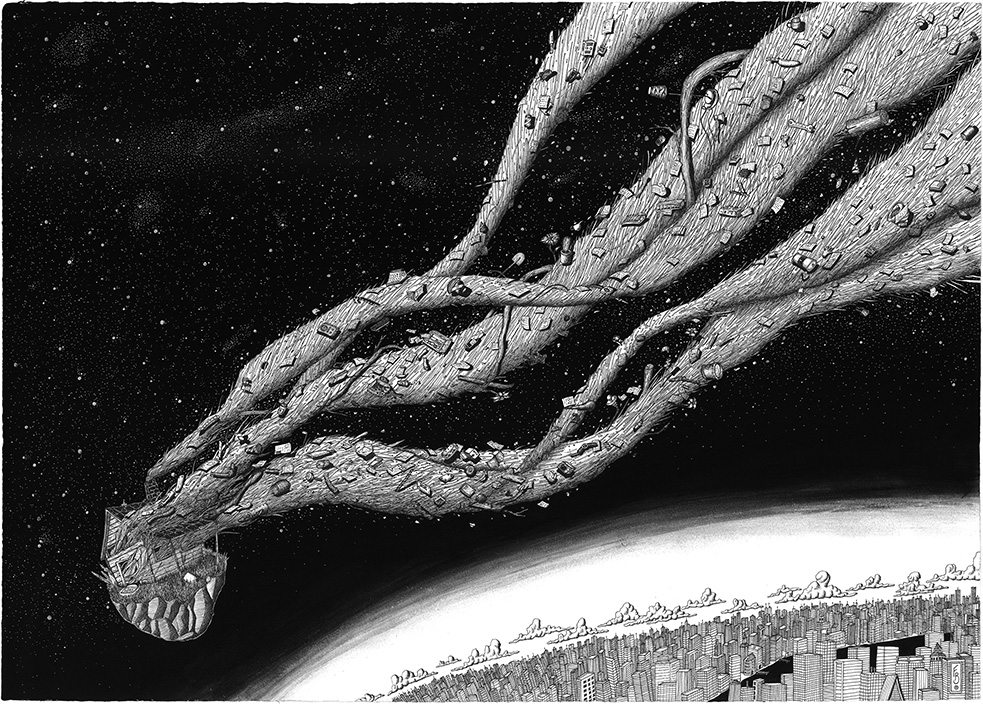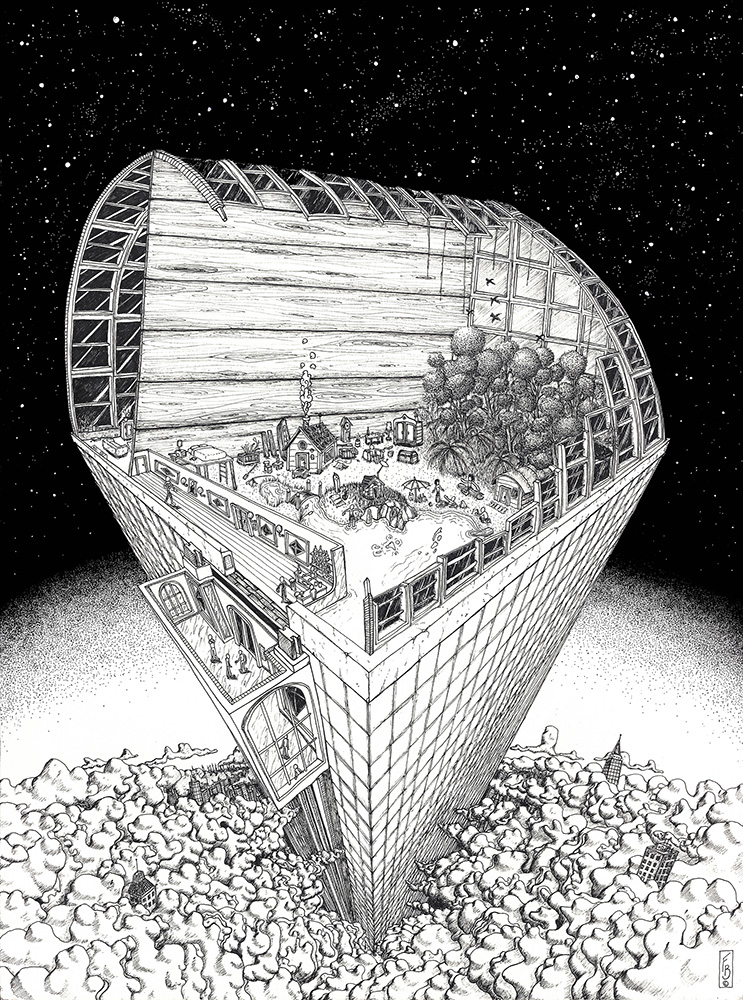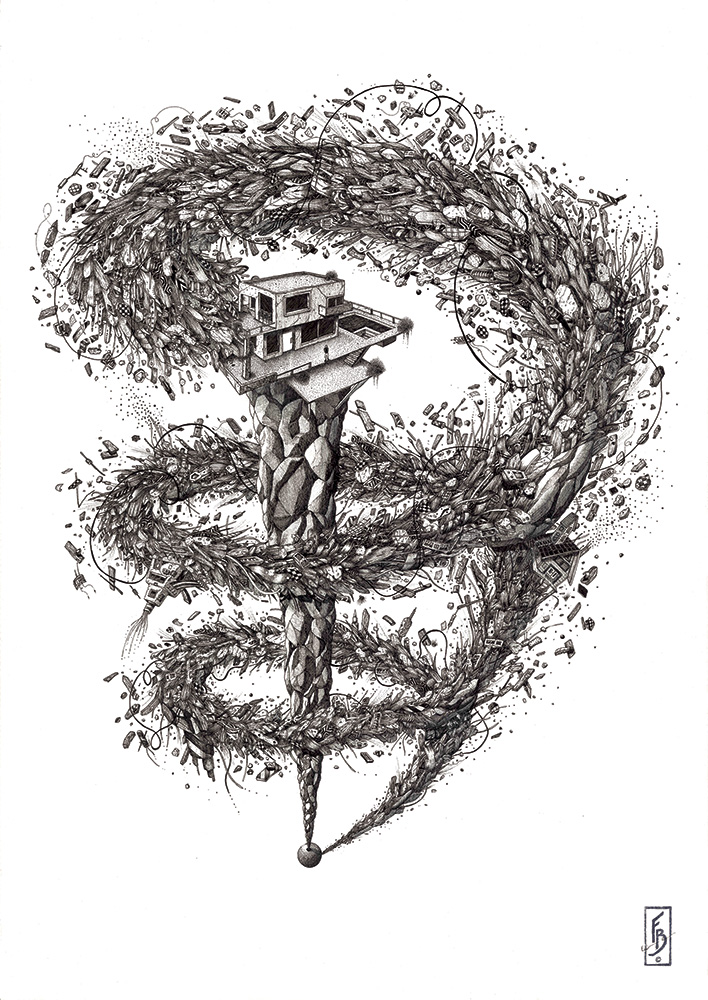Federico Bria: Un paesaggio del futuro
di Federico Bria
Quando mi è stato proposto di partecipare al talk intitolato Towards 2050 – Visions from 2050, all’interno della splendida cornice della XVII Mostra Internazionale di Architettura della Biennale di Venezia, ho avuto modo di riflettere molto sulla tematica di come potrebbe essere il nostro futuro. Il mio compito, come quello degli altri artisti / architetti invitati, era quello di rappresentare a livello grafico uno scenario, un mondo nel quale potremmo ritrovarci da qui a 30 anni.
Ho cercato di approfondire alcune questioni che giorno dopo giorno acquisiscono maggior importanza, riguardanti il cambiamento climatico, l’inquinamento, il crescente rapporto che abbiamo con la tecnologia e con la natura e, non ultimo, il rapporto che abbiamo con noi stessi.
Sono temi sui quali rifletto da tempo e che mi hanno portato a vedere l’uomo come uno degli esseri più intelligenti sul nostro pianeta, ma allo stesso tempo uno dei più ingenui.
Fino a quando non si trova sull’orlo del baratro continua a camminare, facendo quasi finta di nulla pur sapendo che sta andando incontro all’oblio. Solo sentendo l’odore del fondo, vedendone l’oscurità, riflette su tutte le geniali invenzioni che ha elaborato per salvarsi.
Partendo da questi presupposti, In 2050 ho rappresentato uno scenario semi-sommerso che, vuoi per innalzamento dei mari o per desertificazione, ha portato l’umanità a raccogliersi su delle isole, concentrandovi tutti gli strumenti tecnologici possibili per poter sopravvivere e innescare un cambiamento in grado di riportare il pianeta ad una parvenza di vivibilità. Mi immagino l’installazione di tutte quelle tecnologie che, pur avendo avuto in questi ultimi anni un’accelerazione nel loro utilizzo, restano confinate come esempi virtuosi invece che essere la normalità, semplicemente perchè (ancora) non convengono a livello economico. Impianti di raccolta della Co2 (DAC) su ogni edificio, usi massicci del fotovoltaico ed energia eolica, giardini verticali e una riscoperta del vivere comune attraverso, ad esempio, gigantesche piattaforme agricole che fungono anche da ponti di collegamento.
Tuttavia, l’uomo del primo mondo non riuscirà facilmente a rinunciare a determinati lussi e privilegi, come il consumo di carne (in 2050 una struttura denominata “Fartory” sarà in grado raccogliere le esalazioni degli animali per produrne energia) o la libertà di poter fare delle passeggiate nella natura, o in quello che ne resta.
Mi immagino, in un mondo del genere, dei vettori come ECHO, ovvero navi che prima portavano combustibili fossili e adesso trasportano foreste da un un punto all’altro del pianeta, esaltando e distribuendo una tecnologia naturale che da miliardi di anni serve per generare ossigeno ed assorbire Co2: la fotosintesi.
Queste riflessioni mi hanno fatto ripensare a un’illustrazione che feci nel 2018, basandomi su un sogno fatto una notte dell’anno prima. Dreamloft rappresenta un gigantesco appartmento in cima a un grattacielo contenente una sorta di micromondo, con un mare interno, una giungla, elementi di arredo sparsi sulla spiaggia, un mondo lontano dalla bolgia terrena, nel quale si gode di un ritrovato benessere.
Ciò che trovai più interessante in quella dimensione onirica fu che questo appartamento, seppur considerato esclusivo per struttura e fattezze, era aperto a chiunque lo desiderasse.
Mi piace pensare ad un ritorno all’inclusività, alla disponibilità ed alla condivisione, in antitesi troppo spesso con i modelli economici e finanziari odierni, le cui crepe si iniziano a vedere da anni, riparate temporaneamente con toppe inefficaci invece di ripensare ad una nuova architettura di scambio, più solida ed equa. Come dicevo, l’uomo è incline a continuare per la propria strada chiudendo gli occhi di fronte ai problemi che, ovviamente, ad un certo punto ci presenteranno il conto.
In ESCAPE, illustrazione che ho fatto durante il primo lockdown nel 2020, questa fuga si lascia dietro tutti i pensieri e i problemi come la coda di una cometa che gira intorno al pianeta.
In NO ESCAPE propongo il messaggio opposto: non serve rifugiarsi in una reggia distaccata dal resto del mondo, perché tutte le questioni dalle quali ci stiamo nascondendo prima o poi ci raggiungeranno: tanto vale provare ad affrontarle, e vedere cosa succede.
 in breve
in breve
Federico Bria – bio
Attivo nel mondo dell’illustrazione dal 2013, si concentra sulla costruzione di universi surreali e silenziosi, mondi onirici che nascondono e raccontano molteplici storie.
Fedele al bianco e nero e ai pennini dal tratto fine, porta avanti diversi progetti artistici, uniti da una costante ricerca della tecnica e dall’ossessione per i dettagli, che ne caratterizzano lo stile.
English version

by Federico Bria
A landscape of the future
When I was asked to join the talk Towards 2050 – Visions from 2050, whitin the fantastic setting of the Biennale di Architettura in Venice in 2021, I had the opportunity to think thoroughly how our future will be. My task, as for the other artists / architects invited, was to create a scenario, a world in which we could live in like 30 years.
I tried to investigate some issues that are day after day more relevant, concerning climate change, pollution, the growing and entangling relationship with technology and nature, and not least, the relationship with ourselves.
These are themes I often think about, and that broguht me to assume that human beings are one of the smartest species on Earth, yet one of the naivest.
Men persist on walking until they find themselves on the edge of an abyss. They go on knowing exactly that this direction will lead them to the end. They consciuously deceive themselves, and only after seeing the darkness of the bottom they remember about all the great technologies they have developed to increase their own quality of life. Starting from these assumptions, in 2050 I drew a semi-submerged scenario which, caused either by sea level raising and desertification, led humanity to gather on islands, concentrating all the technologies available in order to survive and start a changing process able to bring the planet back to a more livable place. I imagine the installation of all these technologies, that despite having been used more and more in recent times, are confined to be virtuous examples rather than being the norm. This only because by now they are not economically convenient. Co2 collection plants (DAC) on every building, massive use of photovoltaics and wind energy, vertical gardens and a rediscovery of common living through, for example, huge agricultural platforms that also act as connecting bridges.
However, the man of the first world will not easily be able to give up on some luxuries and privileges, such as meat consumption (in 2050 a structure called “Fartory” will be able to collect the exhalations of animals to produce energy) or the freedom to be able to take walks in nature, or in its remains.
In such a world, I imagine carriers like ECHO, that is oil tankers previously used for carriyng fossil fuels and now converted to transport forests from one point to another on the planet, praising and distributing a natural technology already used for billions of years to generate oxygen and absorb Co2: photosynthesis.
These thoughts reminds me an illustration I did in 2018 which based on a dream I had the year before. Dreamloft represents a huge apartment on top of a skyscraper containing a sort of microworld, with an inland sea, a jungle, pieces of furniture scattered on the beach. A world away from the earthly bedlam, where one can enjoy a newfound well-being. What I found very interesting in this dreamlike dimension was that this space, perceived as something exclusive and private, was accessible to anyone without restrictions.
I like to think on a return to inclusiveness, helpfulness and sharing, too often in contrast with today’s economic and financial models, whose cracks have been shown up for years, temporarily repaired with ineffective patches instead of rethinking a new architecture of exchange, more solid and fair. As I said, man is inclined to continue on his own path by closing his eyes in front of his problems that, of course, at some point will show us the price for that.
In ESCAPE, an illustration I did during the first lockdown in 2020, this act of fleeing leaves behind all thoughts and problems like a comet’s tail, flying in the sky of our planet.
In NO ESCAPE instead I suggest the opposite message: it’s useless to shelter in a luxurious palace detached from the rest of the world, because all the issues from which we are hiding will sooner or later reach us: it could be a good idea to try to face them, and see what happens.
 short version
short version
Federico Bria – biography
In the illustration world since 2013, he focuses on the construction of surreal and silent universes,
dreamlike worlds in which multiple stories are narrated and concealed. Committed to black and white and thin fine liners, he works on different artistic projects, connected by a constant research on techniques and the obsession for details, features that also marks his style.







